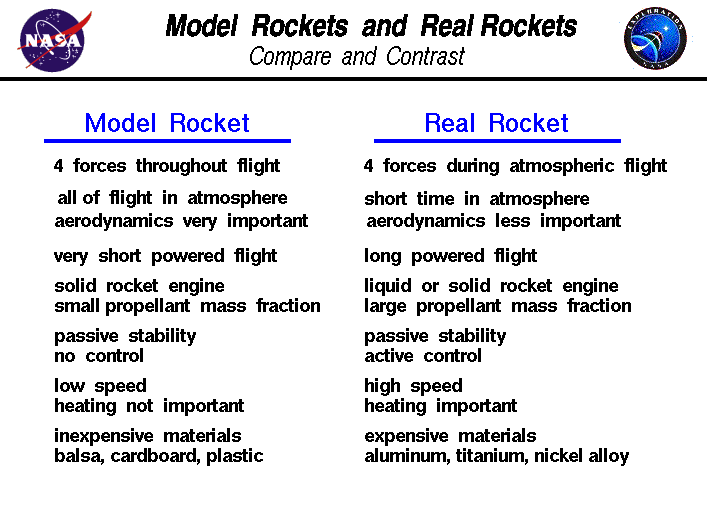Model Rockets and Real Rockets

Flying Model Rockets
Flying model rockets is a relatively safe and inexpensive way for students to learn the basics of forces and the response of a vehicle to external forces. Students can also learn some of the basics of full-scale rocket operation and performance. On this page, we compare and contrast real rockets and model rockets.
Why are Aerodynamic Effects Important for a Rocket?
A model rocket is subjected to four forces during flight; weight, thrust, and lift and drag. The same forces operate on a full scale rocket as it moves through the atmosphere. The flight trajectory of a full scale rocket takes it out of the atmosphere as quickly as possible. Therefore, the aerodynamic lift and drag are less important for a full scale rocket relative to a model rocket. The magnitude of the aerodynamic forces depend on the air density and air density decreases to near zero at the edge of the atmosphere. For model rockets, the entire flight is conducted in the lower atmosphere and the aerodynamic effects are very important.
During powered flight both model rockets and full-scale rockets use a rocket propulsion system. Model rockets employ a variety of small solid rocket engines. There are some larger “amateur” rockets which use liquid or hybrid engines, but these are intended for older, more experienced rocket builders and are not discussed at this site.
Full scale rockets may employ either solid or liquid rocket engines. On full scale rockets, solid engines are often used as “strap-ons” during the first minutes of flight, with liquid engines used for sustainers and upper stages. For a model rocket, the propellant is a small fraction of the weight of the entire rocket, typically 10 – 15%. For a full-scale rocket the propellant represents a large mass fraction of the weight of the vehicle, typically 80 – 85%. Part of the reason for this difference is that model rocket engines burn very quickly, usually less than two seconds. A full-scale rocket engine may fire for 10 minutes to get into orbit.
Stability and Control of Rockets
During flight both model rockets and full-scale rockets must provide some system of stability and control. Stability indicates that if the flight path is slightly perturbed, the rocket will return to the previous path and not fly erratically. Control is the ability to maneuver the rocket during flight. Both model rockets and full-scale rockets are designed with passive stability within the atmosphere. The “passive” part means that the rocket will return to the flight path without moving any control surfaces.
The conditions for stability are that the center of gravity must be located above the center of pressure. Model rockets have no provisions for control. After the rocket leaves the launch rail, it can go anywhere. You watch a model rocket fly; you can’t control it. Model rockets often turn into the wind, in a maneuver called weathercocking, because of aerodynamic forces on the stability fins. Real rockets use very sophisticated instrumentation, computers, and high-speed actuators for flight control. The early V2 had small vanes in the rocket nozzle which would deflect the thrust during flight. Most full-scale rockets use a system called engine gimbals, in which the whole nozzle is rotated while the engine is firing.
Speed Differences in Model and Full-Scale Rockets
Model rockets fly at relatively low speeds (<250 mph) so aerodynamic heating is not a concern. Model rockets are made of inexpensive materials like balsa wood, cardboard, or plastic. Full scale rockets fly very fast (> 10,000 mph) so aerodynamic heating is a big concern. Exotic, expensive materials are used in the construction of real rockets; materials like titanium, and nickel alloys. On some rockets, like the Space Shuttle external tank (ET), special insulating material is applied to the metal skin to prevent damage due to aerodynamic heating. That’s why the ET is orange colored.
